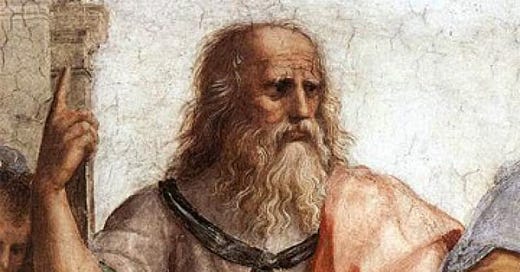Plato’s Allegory of the Cave; a Case for Absolute Truth
And that that Truth is Absolutely Jesus
Plato’s Allegory of the Cave offers a striking image of the soul’s journey from illusion to truth. Though written centuries before Christ, this story prepares the heart for the Christian revelation: that Truth is not an idea, but a person, Jesus Christ. As the Church teaches, man is made for truth, and the light of Christ reveals reality as it truly is. In a culture that prefers shadows and comfort, the call to live in the light is radical. Yet it is there, in the piercing brilliance of divine truth, that we find healing, clarity, and ultimate freedom.
1. Introduction: Why Philosophy Matters for Faith
Plato begins with the illustration of prisoners who have spent their whole lives in chains, backs pressed up against a wall, restrained so they can only stare at the opposing wall where they experience only shadows (the “Realm of Shadows”). Behind them is a fire, and behind the fire is another wall on which puppeteers play, manipulating the shadows the prisoners see (the “Realm of Forms”). Behind the puppeteers is the opening to the cave - daylight - the “Realm of Good.”
What does this ancient philosophical story have to do with the Catholic faith? I offer the thesis that Plato’s cave story is a pre-Christian foreshadowing of the soul’s journey toward God by seeking Truth and, more specifically, a case for Absolute Truth.
“Faith and reason are like two wings on which the human spirit rises to the contemplation of truth.” – Fides et Ratio, St. John Paul II
2. Plato’s Cave in Brief
As the allegory continues, one of the prisoners ventures to escape (and, spoiler alert: succeeds). The story follows one brave man’s journey through the Realms of Forms as he is called to higher thought. He proceeds from the Shadow Realm which is mere illusions, only shadows of truth and finds himself in the Realm of Forms, near the fire. In other words, he encounters truth in the light. However, there is yet still higher to climb. He must exit the cave into the Form of the Good (i.e., The Sun). I posit that this is the Fullness of Truth, Oneness with Christ, Absolute Truth, Heaven itself.
We follow a prisoner’s journey as he escapes the chains and accesses truth in the Realm of Forms (where the puppeteers play) for the first time. At first, he is stunned, hurt, and cannot fathom the lie he has been living.
In Plato’s telling, this journey is not without pain. As the prisoner escapes and ascends, he is at first blinded. The truth wounds before it heals. He is disoriented, stunned, even pained by the light, unable to believe the life he once called reality was nothing but shadow.
Many of us have known this moment in our spiritual lives. We are freed from the bondage of sin, only to be met with the ache of remorse, regret, and shame. It hurts to see clearly …at first.
But take heart: the prisoner will eventually gradually adjust to the light of the fire. He comes to terms with the Truth. He begins to grasp that everything he once thought was real was only a dim reflection of what truly is. He realizes that truth is not just a better version of what he had, it is a wholly different order of being. But, the mere fact that something can be “more true” rationally proves the existence of something absolutely true. (Stay with me…we’re almost there.)
But, at this point in the story, our friend the prisoner believes that the Realm of Forms is the truest of all things, and to him, it is the truest thing he has experienced, and he is dazzled by it. Ah, but there are more things in heaven and earth, Horatio, than are dreamt of in your philosophy.
Something Absolutely True:
Once the prisoner’s eyes have adjusted to the great new discovery of the light, he realizes that there is still more truth to behold. The prisoner lifts his eyes toward heaven and sees sunlight peering through the entrance of the cave. He reaches and walks toward the light - absolute truth - the Realm of Good - to discover beautiful trees, birds, flowers, and such absolutely real objects. No longer shadows or puppets. In the allegory, the Realm of the Good is truly the reason and cause for all other forms. Now he is finally in true understanding.
There are several positions here:
The Shadow Realm: Where the chained prisoners dwell; filled with illusions and projections (falsehood and ignorance).
The Visible Realm: The physical world, apprehended by the senses; better than shadows, but still changeable and imperfect
The Intelligible Realm: The realm accessed through reason and intellect; includes the Realm of Forms, where truth is contemplated.
The Realm of Forms: Eternal, unchanging ideals (e.g., Beauty itself, Justice itself) that give meaning to all material things. (I think the world, for the most part, exists here. Where we only experience shadows of truth)
The Form of the Good: The highest reality; the source of all truth, goodness, and being itself. In a Christian reading, this is Christ, the Logos, the fullness of reality and revelation.
I further posit that while on earth, we either occupy ourselves in the Realm of Shadows or the Realm of Forms, and that, on this earth, we do not have the capacity to exit the cave…at least until death or in perfect union with Christ while still living.
Keep reading with a 7-day free trial
Subscribe to TinyActsCo. to keep reading this post and get 7 days of free access to the full post archives.







